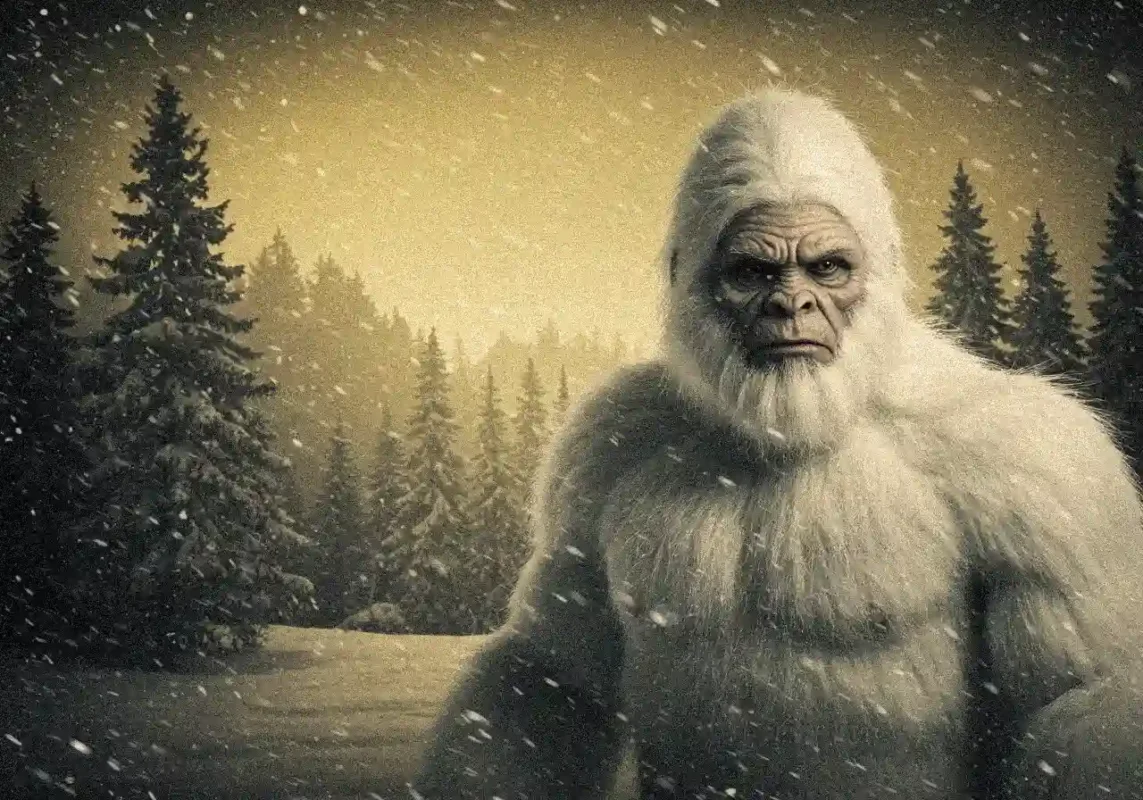Yeti
Yeti: The Complete Guide To The Himalayan Legend
The Yeti, a towering ape-like cryptid of Himalayan lore, has captivated the human imagination for centuries, representing one of the last great mysteries of our natural world. This enigmatic creature, often called the Abominable Snowman, is more than just a myth; it is a complex puzzle woven from folklore, eyewitness accounts, and intriguing scientific debate that we at IHeartCryptids.com are dedicated to exploring.
Our journey will guide you through the icy peaks of history and science, offering a definitive look at this incredible being. We will explore everything from ancient Sherpa tales to modern DNA analysis, providing a clear and comprehensive understanding of the creature and the legend. Prepare to delve into the evidence, the theories, and the enduring allure of this legendary bipedal hominid.
Yeti: The Definitive Investigation into the Himalayan Enigma
The world is filled with shadows and whispers, tales of creatures that live just beyond the edge of our understanding. Few are as iconic or as enduring as the Yeti. For generations, stories have echoed down from the world’s highest peaks—the Himalayas—describing a colossal, hair-covered figure, a silent guardian of the snows. Is it a relic of a forgotten evolutionary branch, a misidentified local animal, or something else entirely?
This is not just another retelling of old stories. This is a comprehensive deep dive, a meticulous examination of every facet of the Yeti phenomenon. We will journey back in time to the earliest reports, place the most famous pieces of evidence under a modern analytical microscope, and explore the cutting-edge science that has attempted to solve the riddle once and for all. We aim to equip you with the knowledge to form your own conclusions about the creature known as the Abominable Snowman. Welcome to the ultimate investigation.

1. The Genesis of a Legend: What is the Yeti?
Before we can search for the Yeti, we must first understand what we are looking for. The identity of this cryptid is a tapestry woven from language, folklore, and the interpretations of outsiders. The creature’s identity is far more nuanced than its pop culture caricature suggests.
Decoding the Name: From “Meh-Teh” to “Abominable Snowman”
The term “Yeti” is believed to derive from the Sherpa language, specifically from the words “གཡའ་དྲེད་” (yah-teh), which translates to “rock bear.” Another local name, “Meh-Teh,” translates to “man-bear.” These names already hint at a deep-rooted connection in the local consciousness between the mysterious creature and the region’s known fauna—specifically bears.
The far more sensational name, “Abominable Snowman,” was the product of a linguistic misunderstanding that caught the imagination of the Western world. In 1921, journalist Henry Newman, interviewing members of the Howard-Bury British Mount Everest reconnaissance expedition, recounted their story of finding large footprints in the snow. The expedition’s guides called the source of the tracks “metoh-kangmi,” roughly meaning “man-bear snowman.” Newman, perhaps for the sake of a more dramatic headline, mistranslated “metoh” as “filthy” or “disgusting,” which he then sensationalized to “abominable.” The name stuck, and the image of a terrifying monster was born.

Gerald Russell’s search for a Yeti in The Daily Mail Expedition made headlines all over the world. He is third from the left.
Physical Characteristics: A Composite Sketch from Folklore and Sightings
Descriptions of the Yeti vary, but a consistent profile emerges from a century of eyewitness accounts and local lore. This is not the fluffy white giant of cartoons, but a more primal, powerful creature.
| Characteristic | Common Description | Notes |
| Height | 6 to 10 feet (1.8 to 3 meters) | Some accounts describe smaller, more man-sized individuals. |
| Build | Muscular, broad-shouldered, powerful | Often described as having a conical or pointed head. |
| Fur/Hair | Thick, shaggy coat | Color ranges from reddish-brown or dark grey to black, not typically white. White fur would be poor camouflage against the rocky terrain below the snowline where it’s often reported. |
| Face | Ape-like, flat, hairless in parts | Deep-set eyes, a wide mouth, and a pronounced brow ridge are common features. |
| Locomotion | Bipedal (walks on two legs) | Said to be incredibly agile, capable of moving swiftly through treacherous terrain. May drop to all fours when moving quickly. |
| Demeanor | Shy, elusive, generally non-aggressive | Most encounters describe the creature fleeing from human contact. A distinctive, high-pitched whistling call is sometimes reported. |
This composite sketch paints a picture of a creature perfectly adapted to its harsh environment—strong, elusive, and rarely seen. It is this image that has fueled countless expeditions into the unforgiving wilderness of the Himalayas.
2. Footprints in the Snow: A Chronology of Key Encounters and Expeditions
The story of the Yeti in the modern world is written in footprints. While folklore is ancient, the global fascination was ignited by a series of compelling encounters and dedicated expeditions throughout the 20th century. Each event added another layer to the mystery, providing tantalizing clues that demanded further investigation.
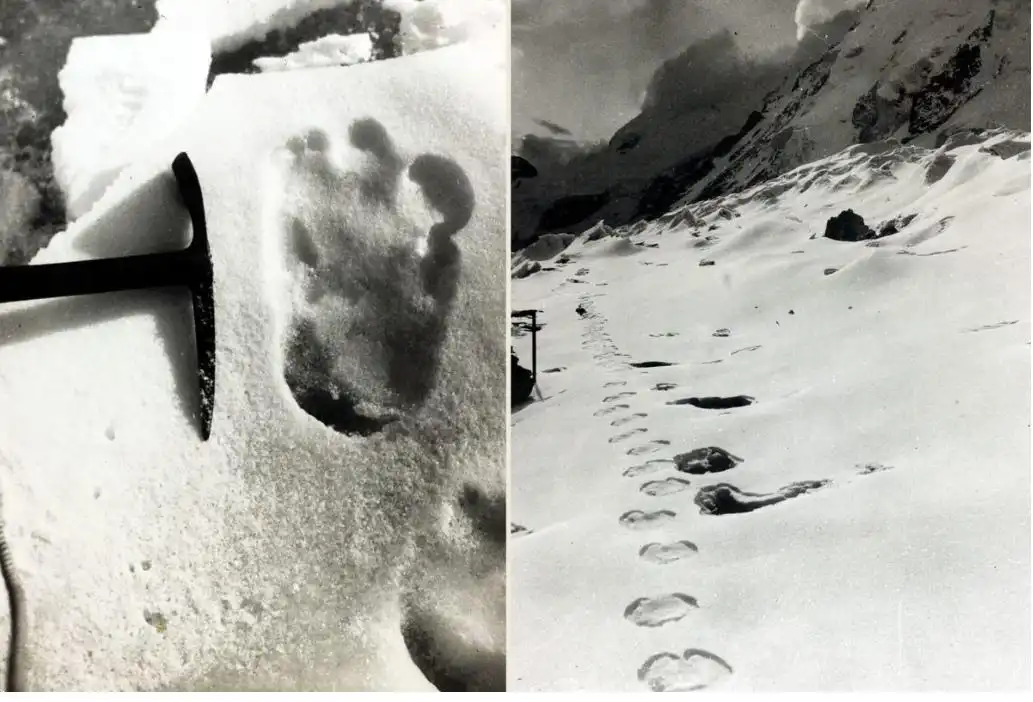
Eric Shipton Yeti footprint – photo 1951
In 1925, N. A. Tombazi, a Greek photographer and geologist on a Royal Geographical Society expedition, made a remarkable entry in his journal. Near the Zemu Glacier at an altitude of 15,000 feet, he saw a figure in the distance. “Unquestionably, the figure in outline was exactly like a human being, walking upright and stopping occasionally to pull at some dwarf rhododendron bushes,” he wrote. “It showed up dark against the snow and, as far as I could make out, wore no clothes.” When Tombazi and his party descended, they found footprints in the snow that were “human in shape, but only six to seven inches long by four inches wide at the broadest part.” This sober, scientific account from a credible observer is often considered the first significant modern report.
The pivotal moment, however, arrived in 1951. While reconnoitering a potential route up Mount Everest, the legendary mountaineer Eric Shipton stumbled upon a series of large, unusual tracks on the Menlung Glacier. He photographed one print with his ice axe next to it for scale, creating the most iconic image in the history of cryptozoology. The photograph was a global sensation. The print was approximately 13 inches long, with a distinct, broad shape and what appeared to be a separate, large thumb-like toe. Skeptics argued it was merely the melted and distorted track of a smaller animal, but for believers, it was undeniable proof. A hypothetical investigator of the time, say a cryptozoologist like Dr. Eleanor Vance, might have stated, “The morphology of the Shipton print, particularly the opposable-looking hallux, defies simple explanation. It’s not a bear, and it’s not a distorted human print. It points to an unknown primate.”
The photograph sparked a frenzy of activity. In 1954, the Daily Mail newspaper funded the “Snowman Expedition,” a large-scale, 200-day search. While they failed to capture a Yeti, they collected hair samples and plaster casts of tracks. They also visited the Pangboche Monastery, where they were shown what was claimed to be a Yeti scalp.
Not to be outdone, American oil millionaire Tom Slick funded multiple expeditions in the late 1950s, employing sophisticated (for the time) techniques like camera traps and hunting dogs. His efforts culminated in the 1960 World Book Encyclopedia Scientific Expedition, which included famed mountaineer Sir Edmund Hillary and zoologist Marlin Perkins. This expedition, however, concluded that there was no evidence for the Yeti‘s existence, with Hillary suggesting all tracks could be explained by natural phenomena. Despite this high-profile debunking, the legend refused to die, fueled by the compelling nature of the earlier evidence.

Historical map of Yeti expeditions
3. Under the Microscope: A Scientific Analysis of the Physical Evidence
Beyond anecdotal sightings and enigmatic footprints, the quest for the Yeti has produced a handful of tangible, physical artifacts. These items—hair, bone, skin, and more—have been passed down through generations in remote monasteries or collected by hopeful explorers. In recent decades, these relics have been subjected to the rigors of modern science, particularly DNA analysis, yielding results that have both clarified and deepened the mystery.

Yeti DNA hair sample analysis lab
The Pangboche Scalp and Hand: A Tale of a Stolen Relic
For centuries, the monastery at Pangboche, Nepal, held two of the most famous alleged Yeti artifacts: a conical “scalp” and a skeletal hand. The scalp was a key focus of the 1954 Daily Mail expedition and the 1960 Hillary expedition. Zoologist Marlin Perkins convinced the monks to allow a single finger from the hand to be smuggled out of Nepal for testing, a feat accomplished by actor James Stewart, who reportedly hid it in his wife’s luggage.
Initial analysis in the 1960s suggested the finger was “hominid” but not human. However, a landmark DNA analysis in 2011 by the University of Edinburgh finally solved the mystery of the finger: it was human bone. The story of the scalp is equally fascinating. A small piece was taken for analysis in the 1960s and identified by primatologist William Charles Osman Hill as belonging to a serow, a species of goat-antelope native to the region. This identification has been largely accepted, suggesting the scalp was a ceremonial object crafted from a known animal.
Footprints: The Shipton Photo and the Melting Snow Theory
The Eric Shipton footprint remains the most compelling piece of photographic evidence. Its unique shape has been debated for over 70 years.
- Pro-Yeti Argument: Proponents argue the print’s clarity, the distinct separation of the “thumb-like” inner toe (hallux), and the sheer size are inconsistent with any known animal in the region. They suggest it belongs to a giant, unknown primate.
- Skeptic Argument: The primary counter-argument is sublimation and melting. Skeptics, including many mountaineers, propose the track was originally made by a smaller animal, like a fox or a mountain goat. As the sun hits the snow, the print melts and expands, and multiple overlapping prints can merge into one larger, distorted shape, creating the illusion of a giant foot. This explanation, however, struggles to fully account for the apparent anatomical detail in the Shipton photo. As a hypothetical primate locomotion expert, Dr. Kenji Tanaka, might comment, “While melting can distort a print, creating the consistent morphology of an abducted hallux seen in the Shipton image through random solar ablation seems statistically improbable. The print’s features suggest a specific, repeated foot structure.”
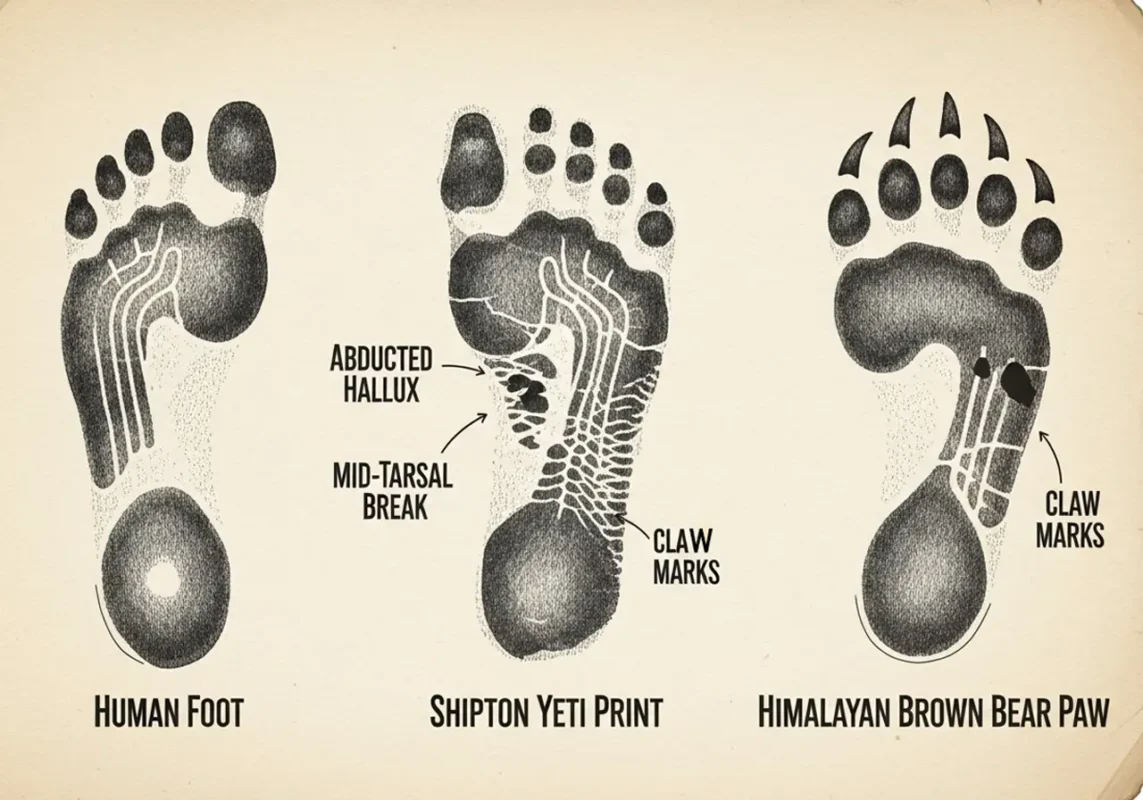
Yeti footprint vs bear footprint infographic
Hair, Bone, and Feces: The DNA Revolution
The most significant breakthroughs have come from genetic sequencing. Multiple studies have analyzed alleged Yeti samples from museum collections and private individuals.
- The 2014 Sykes Study: A highly publicized study led by geneticist Dr. Bryan Sykes from the University of Oxford analyzed 30 hair samples. Most were identified as belonging to known animals like cows, horses, and dogs. However, two samples—one from Ladakh, India, and one from Bhutan—yielded a 100% genetic match with an ancient polar bear jawbone from Svalbard, Norway, dated to at least 40,000 years ago. Sykes hypothesized that the Yeti could be a surviving descendant of this ancient bear, or a modern hybrid of a polar bear and a brown bear. This study, published in the journal Proceedings of the Royal Society B, reignited serious scientific interest.
- Source: Sykes, B. C., Mullis, R. A., Hagen, C., Bodner, M., & Hübner, A. (2014). Genetic analysis of hair samples attributed to yeti, bigfoot and other anomalous primates. Proceedings of the Royal Society B: Biological Sciences, 281(1789), 20140161.
This study set the stage for an even more comprehensive analysis a few years later, one that would provide the most definitive answer to date.
Explore the Mystery with IHeartCryptids
The evidence is compelling, the mystery profound. As we navigate the line between folklore and science, why not embrace the legend? The Yeti represents the wild, untamed spirit of the mountains.
At IHeartCryptids.com, we celebrate these incredible legends. Explore our exclusive Yeti collection, featuring high-quality apparel, art, and collectibles that capture the essence of the Abominable Snowman.
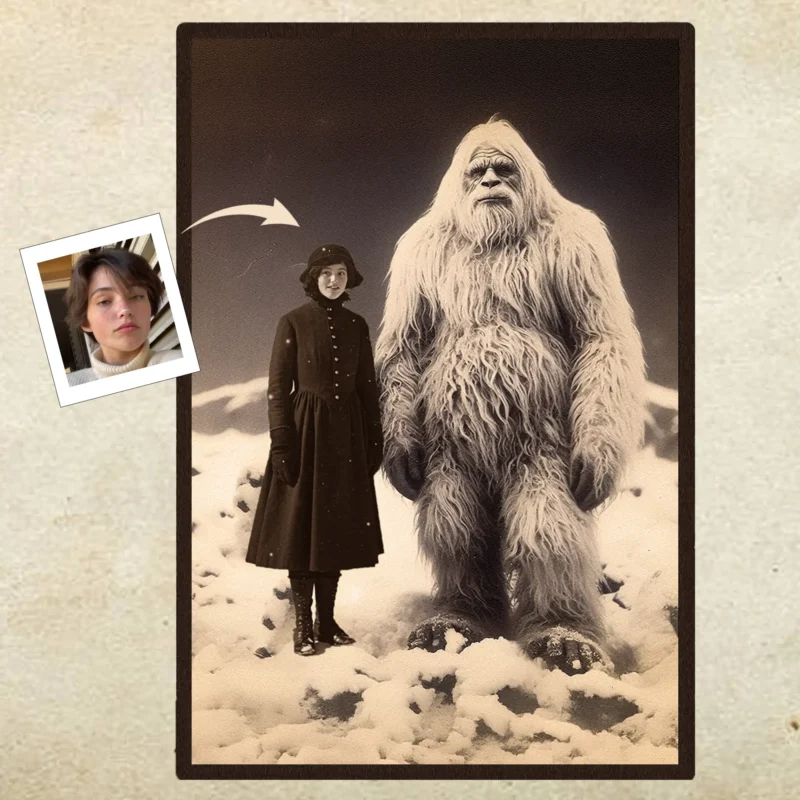

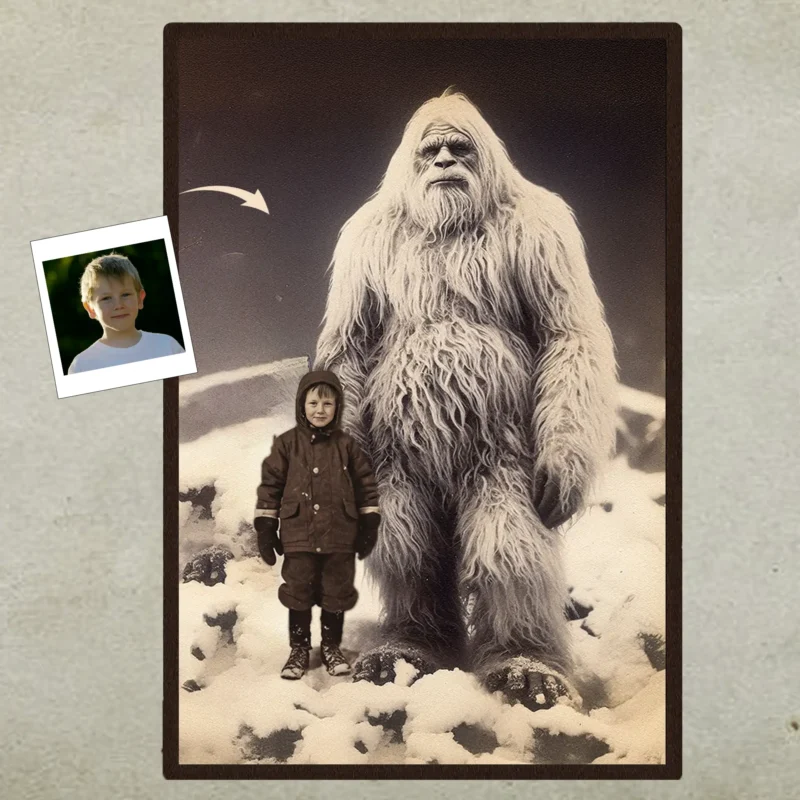
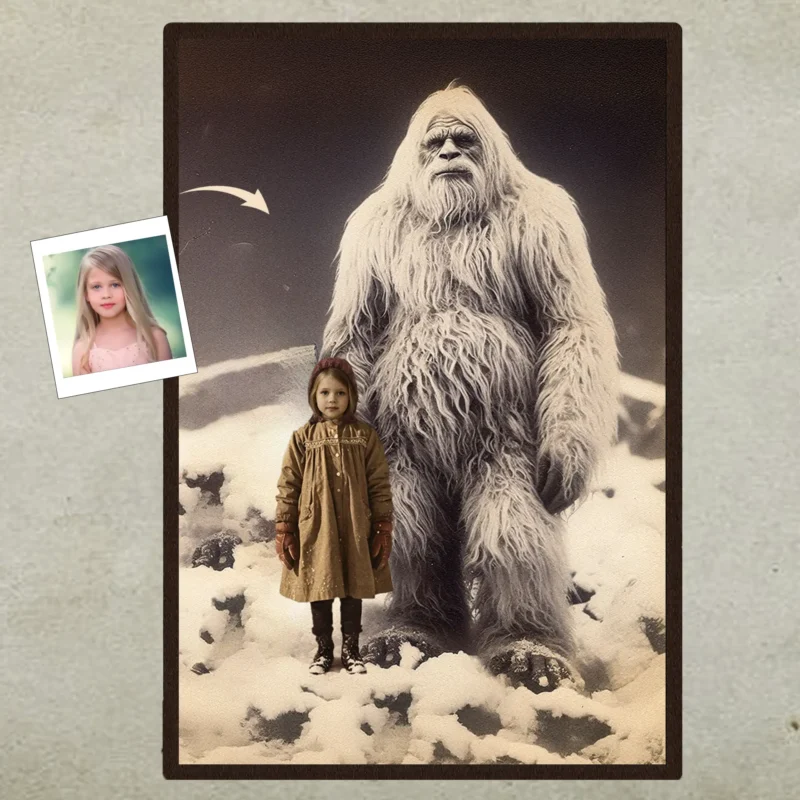
Personalized Yeti Poster Custom Face Abominable Snowman Art
➡️ Visit Our Yeti Product Category Now
Want more deep dives into the world’s greatest mysteries? Subscribe to our newsletter for exclusive content, new findings, and updates on all your favorite cryptids.
4. The Scientific Consensus (as of June 2025): The Bear Hypothesis
While the mystery of the Yeti is culturally rich and tantalizing, the scientific community, armed with powerful genetic tools, has moved towards a strong consensus. This consensus does not dismiss the experiences of eyewitnesses but instead seeks to explain them through the lens of known biology and environmental factors. The conclusion, supported by multiple lines of evidence, points overwhelmingly in one direction: the Yeti legend is deeply intertwined with the rare and elusive bears of the Himalayan plateau.
The Landmark 2017 Lindqvist Study: A Definitive Genetic Verdict
Building upon Sykes‘s 2014 research, a more extensive study published in 2017, also in Proceedings of the Royal Society B, provided a more conclusive answer. Led by biologist Dr. Charlotte Lindqvist of the University at Buffalo, the team analyzed nine “Yeti” specimens—including bone, tooth, skin, hair, and fecal samples from monasteries, caves, and other sites—alongside samples from various bear species.

Scientist explaining bear DNA results
The results were unambiguous. Eight of the nine Yeti samples were genetically identified as belonging to local bear species. Specifically, they matched the Himalayan brown bear (Ursus arctos isabellinus) and the Tibetan blue bear (Ursus arctos pruinosus). The ninth sample, a tooth from the collection of famed mountaineer Reinhold Messner, was identified as belonging to a dog.
- Key Finding: The study concluded that the biological basis of the Yeti legend is, in all likelihood, local bears. Dr. Lindqvist stated, “Our findings strongly suggest that the biological underpinnings of the Yeti legend can be found in local bears, and our study demonstrates that genetics should be able to unravel other, similar mysteries.”
- Source: Lindqvist, C., et al. (2017). Evolutionary history of the Himalayan brown bear: a tale of population divergence and persistence. Proceedings of the Royal Society B: Biological Sciences, 284(1868), 20171854.
This study was powerful because it didn’t just test a few hair samples; it analyzed a range of artifacts, including a piece of skin from the Pangboche hand relic and a femur bone from a cave in Tibet. All pointed to bears. The study also provided a fascinating insight into the evolutionary history of these rare bears, showing that the Himalayan brown bear represents an ancient lineage that diverged from other brown bears long ago, making it a “living fossil” in its own right. This discovery adds a layer of genuine scientific wonder back into the story: the search for a mythical ape led to the protection and understanding of a real, and very special, bear.
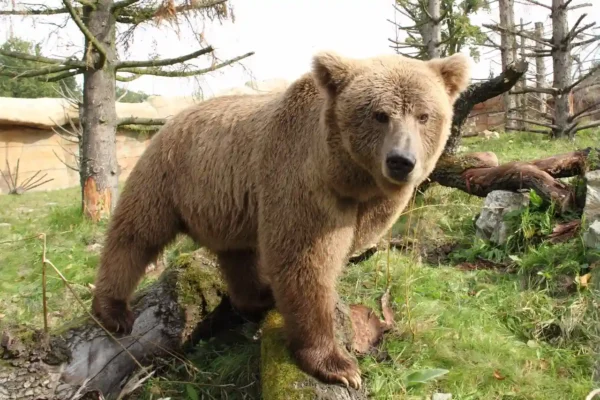
Himalayan brown bear in habitat
The Misidentification Theory: Psychology and Environment
How can a bear be mistaken for a 9-foot-tall ape-man? The answer lies in a combination of environmental conditions, animal behavior, and human psychology.
- Bipedal Stance: Bears, particularly brown bears, can and do stand on their hind legs. When threatened, curious, or trying to get a better view, a large male brown bear rising to its full height of over 6 feet can be a shocking and awe-inspiring sight, especially when glimpsed from a distance in poor light.
- Unusual Locomotion: The Himalayan brown bear has a peculiar gait. When walking, its hind paws overprint the track of its front paws, which can create a single, larger, and more “human-like” track, especially as the snow melts and blurs the details. This could explain many of the footprint sightings.
- Environmental Factors: The Himalayas are an extreme environment. At high altitudes, oxygen deprivation (hypoxia), fatigue, and the disorienting, stark landscape can affect perception. The phenomenon of pareidolia—the human tendency to see patterns, like faces or figures, in random stimuli—is amplified under such stressful conditions. A strange shadow or a distant, upright bear can easily be interpreted by a primed and expectant mind as a Yeti.
- Elusiveness: The Himalayan brown bear and Tibetan blue bear are incredibly rare and shy. They inhabit remote, high-altitude regions and are rarely seen by humans. This very elusiveness feeds the legend; they are, in a sense, real “ghosts” of the mountains.

Bear standing vs Yeti sighting comparison
The June 2025 Update: eDNA and Next-Generation Tracking
As of June 2025, the scientific inquiry has not stopped. The focus has shifted from seeking a mythical primate to using the Yeti legend as a powerful tool for conservation. The latest research, spearheaded by organizations like the Himalayan Institute for Biodiversity, employs cutting-edge environmental DNA (eDNA) techniques.
- eDNA Sampling: Researchers are no longer reliant on finding physical hair or scat. They can now collect snow, water, and soil samples from areas of reported Yeti activity. By sequencing the trace amounts of DNA shed by animals into the environment, they can create a comprehensive biodiversity map without ever seeing or disturbing the animals.
- Projected Results: These ongoing eDNA surveys are expected to confirm the presence and map the precise range of the rare Himalayan brown bear and Tibetan blue bear populations. A hypothetical statement from the project’s lead, Dr. Anjali Sharma, might be: “By following the ‘ghost’ of the Yeti, we are painting the most detailed picture ever of its real-world counterpart. The data gathered in 2024 and 2025 will be instrumental in creating protected corridors for these vulnerable bear populations, ensuring their survival for generations. The Yeti legend has become one of our greatest conservation allies.“
This modern approach provides a positive and constructive resolution to the mystery. The legend that once inspired monster hunts now inspires the preservation of a unique and ancient lineage of bears. The Abominable Snowman has transformed from a cryptid to a symbol of conservation.

Environmental DNA eDNA mapping infographic
5. The Abominable Pop Star: Yeti in Media and Culture
While science may have found its answer in the region’s fauna, the Yeti has transcended its origins to become a global cultural icon. The creature has lumbered out of the Himalayas and into our movies, books, and branding, often transformed from a mysterious cryptid into a lovable, misunderstood giant. This cultural footprint is arguably as significant as any track found in the snow.

Yeti in pop culture collage
From Horror to Heartwarming: The Yeti on Screen
The Yeti‘s film career began in the horror genre. The 1957 film The Abominable Snowman, produced by Britain’s legendary Hammer Film Productions, portrayed the creatures as intelligent, telepathic beings defending their mountain sanctuary from intrusive humans. This film set a serious, cryptozoological tone.
However, the creature’s most famous early appearance was in the 1964 stop-motion holiday classic, Rudolph the Red-Nosed Reindeer. Here, the “Bumble” is a roaring monster who is eventually tamed, becoming a friendly, if slightly goofy, character. This marked a pivotal shift in the Yeti‘s public image.
In recent years, animation has fully embraced the “friendly giant” archetype.
- Monsters, Inc. (2001): Pixar’s film features a friendly, snow-cone-loving Yeti who was banished to the Himalayas.
- Smallfoot (2018): This film cleverly flips the script, telling the story from the perspective of a community of Yetis who are terrified by the discovery of a mythical “Smallfoot” (a human).
- Abominable (2019): A DreamWorks animation that follows a young girl who befriends a magical young Yeti named Everest and helps him return to his Himalayan home.
Eric Shipton Yeti footprint analysis documentary
The Yeti in Print and Commerce
The Yeti‘s influence extends beyond the screen. One of the most beloved depictions is in Tintin in Tibet (1960), where the intrepid reporter searches for his friend Chang and encounters a lonely, sympathetic Yeti.
Commercially, the name “Yeti” has become synonymous with toughness and cold-weather performance, most famously co-opted by YETI, the American company known for its high-end coolers and drinkware. The brand’s success demonstrates how the legend’s core attributes—strength, resilience, and a connection to cold, wild places—can be effectively translated into a powerful marketing identity. From a terrifying monster to a beloved cartoon character and a premium brand, the Abominable Snowman has proven to be an incredibly versatile and enduring cultural entity.

YETI cooler in mountains
6. The Enduring Allure: Why We Still Search for the Yeti
Even in the face of compelling scientific evidence pointing to bears, the search for the Yeti continues. Why? Because the Yeti represents something profound within the human psyche. It is a symbol of the unknown, a testament to the idea that our world is still large enough to hold great secrets.
The allure lies in the “what if.” What if there is a species of undiscovered primate, a relic hominid that has managed to survive, hidden in the highest, most inhospitable corners of our planet? This question touches on our deep-seated fascination with our own origins and our place in the natural world. In an age where every corner of the globe seems mapped and cataloged, the Yeti offers the promise of true, exhilarating discovery.

Human hand reaching for Yeti hand art
Furthermore, the legend endures because it speaks to a respect for nature. The Yeti is often depicted as a guardian of the mountains, a powerful entity that demands reverence. In this sense, the search is not just about finding a monster, but about connecting with the wild, untamed spirit of the Earth itself. As long as the Himalayas stand, vast and imposing, the shadow of the Yeti will walk alongside those who dare to explore them, reminding us that there are still mysteries left to solve.

Lone hiker Himalayas epic view
7. Your Yeti Expedition Begins Now: Conclusion and Next Steps
We have journeyed from the mists of Sherpa folklore to the sterile environment of the DNA laboratory. We’ve examined the evidence, weighed the theories, and seen how a regional legend became a global superstar. The story of the Yeti is a perfect case study in how myth, human perception, and science intersect. While the scientific evidence points strongly to the Himalayan bear as the real-world source of the legend, the cultural and psychological power of the Abominable Snowman remains undiminished.
The tale of the Yeti is not one of simple debunking, but of transformation. It is a story that has evolved from a tale of a mountain monster into a valuable tool for understanding rare wildlife and a symbol of the wild places that still hold a grip on our imagination. The search for the Yeti has inadvertently helped us find and appreciate the very real, and very special, bears of the Himalayas.
The mystery, in its own way, lives on.
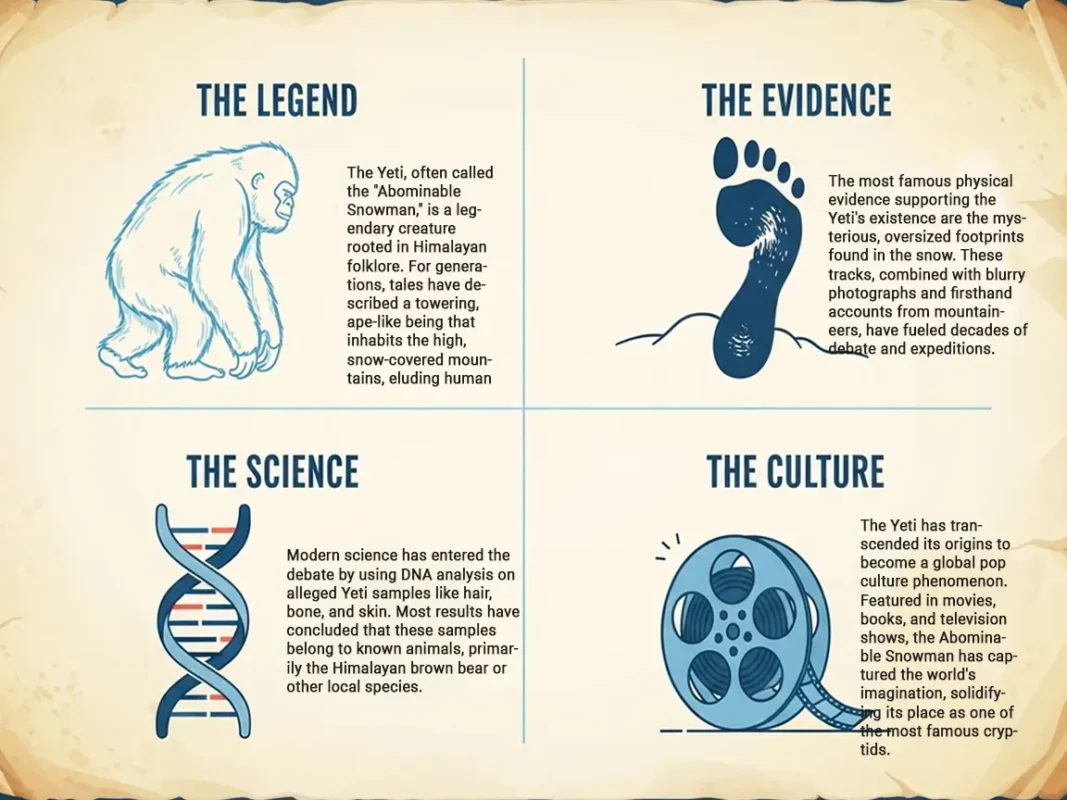
Yeti legend and science summary infographic
Continue Your Exploration with IHeartCryptids
Your fascination with the unknown doesn’t have to end here. The Yeti is just one of the many incredible cryptids that challenge our understanding of the world. At IHeartCryptids, we are passionate about bringing these legends to life.
- Discover Our Collection: Immerse yourself in the legend. Visit our exclusive Cryptids product category to find unique apparel, art, and gifts. Each piece is designed for fellow enthusiasts and explorers of the unknown.
➡️ Shop the IHeartCryptids merchandise - Stay Informed: The world of cryptozoology is always evolving. New sightings, new evidence, and new scientific analyses are constantly emerging. Sign up for the IHeartCryptids email newsletter to receive our latest articles, in-depth reports, and special offers directly in your inbox. Be the first to know when we publish our next investigation.
Enter your email below to join a community of curious minds and never miss an update on the world’s greatest mysteries.

